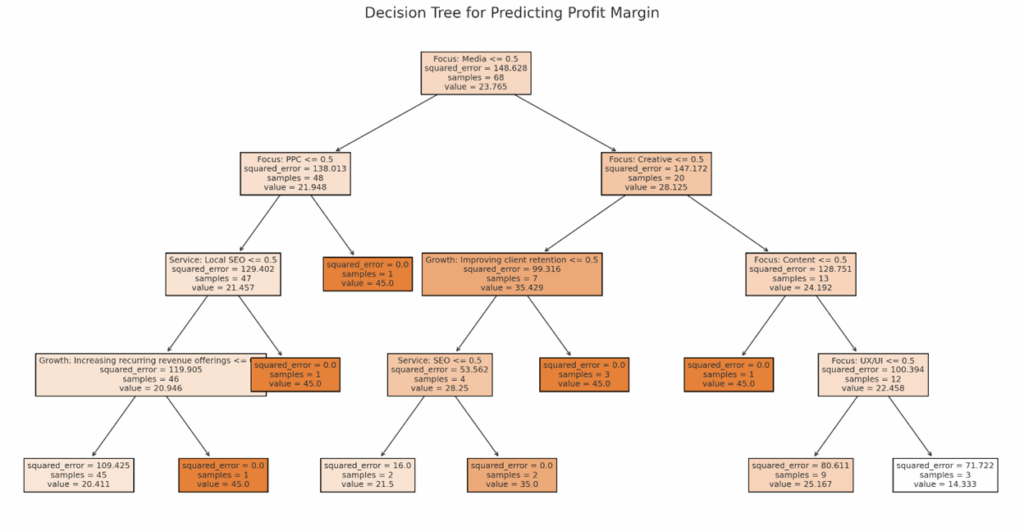What Makes Agencies Predictably Profitable: A Data-Backed Formula

Over the past three decades, I’ve collaborated with agencies of all shapes and sizes, from boutique design firms to mid-sized regional digital agencies to full-service national firms. As Executive Director of NextNW, I’m speaking with more agency executives than ever before. Across that spectrum, a common question keeps surfacing: What really drives profitability in a modern agency setting?
From my experience, the size of a firm has a negative correlation to profitability, yet I have a limited data set. Recently, we partnered with Sonnet Digital to analyze the raw data from a recent survey they conducted with ~90 agencies. Sonnet’s in-depth report, “State of the Independent Agency: Challenges and Opportunities”, gathered insights from agencies across the Pacific Northwest and beyond. Our collective objective was to pinpoint what distinguishes profitable firms from those treading water.

1. Core Services That Drive Revenue
Some offerings clearly outshine the rest when it comes to margin impact: Data Analytics, Media (including PPC and programmatic), Local SEO, and Conversion Rate Optimization (CRO). Agencies that lean into these service areas consistently rank among the most profitable.
Why? These services produce results that are trackable and tied directly to business outcomes. CRO, for example, links marketing work to client revenue growth in a tangible way. Clients see the value, and that trust builds loyalty.
Top performers don’t necessarily offer the most services—they’re simply selective about what they offer and how they deliver it.
2. Retention as a Revenue Multiplier
The idea that retaining a client is more cost-effective than acquiring a new one isn’t new. What’s different now is how formalized successful agencies have made that process. Structured systems—quarterly reviews, net promoter scoring, and proactive client outreach—translate to real financial results.
One agency profiled in the report boosted profits by over 20% in just 12 months after implementing a dedicated client success framework. The shift was cultural as well as operational.
Agencies focused on nurturing client partnerships over time create deeper value and more consistent revenue.
3. Strategy Mapping Through Decision Trees
We used a decision tree model to dig deeper into what leads to above-average profit margins. Agencies that started with a Media-first strategy, then invested in client retention, and expanded into Local SEO and CRO, consistently landed in the top margin bracket.
It wasn’t about a single standout service—it was about how those services worked together. The most profitable agencies combine complementary strengths to serve clients at multiple stages of their marketing journey.
By contrast, firms that lacked retention processes or stayed generalist struggled to scale margins meaningfully.
4. Operational Discipline Makes a Difference
Agencies that commit to tight operations and focused positioning tend to outperform. Whether through vertical specialization or improved internal workflows, discipline pays.
One standout agency focusing solely on legal services had customized tools, repeatable delivery models, and pricing aligned with market value. Their vertical alignment not only made operations smoother—it also made their marketing more effective, too.
Tech-forward teams also benefited by automating labor-intensive tasks like reporting and proposal building, allowing talent to focus on higher-impact strategy.
5. Common Pitfalls of Underperforming Agencies
Some patterns were consistent among agencies reporting lower margins:
- Lack of standardized pricing or consistent scope of work
- Reactive client management with no clear success metrics
- Operating solely on one-off projects without retainer or recurring models
These traits often stem from a lack of positioning or internal process. Without a framework, even strong creative talent can’t offset margin leakage.

6. A Practical Path to Better Profitability
Here’s how agencies of all sizes can improve their bottom line:
- Build up proven services like Data Analytics, Media buying, CRO, and Local SEO. These offerings provide leverage through results-driven work and long-term client needs.
- Establish systems for client retention. Use tools like structured check-ins, success planning, and QBRs to stay proactive. Retention isn’t an outcome—it’s an investment.
- Grow existing relationships. Strategic upselling works best when it’s consultative. Don’t just push add-ons—position solutions based on client goals and measurable impact.
- Streamline delivery with automation. From dashboards to workflow tools, smart tech choices can enhance output without bloating headcount.
- Specialize where it counts. Define a niche based on strength or demand. The clearer your agency’s focus, the more magnetic your messaging and margins become.
- Align your efforts strategically. Layer services and business development to reinforce one another. The most successful firms don’t just stack offerings—they weave them into a growth engine.
Final Thoughts: Make Profit a Process
The findings from this research aren’t hypothetical. They reflect tangible steps agencies are taking to build more sustainable, margin-rich businesses. The good news? With discipline and alignment, any agency can implement these strategies.
Want to explore these insights with your team? Request a downloadable version of the full report or a strategic worksheet to bring to your next planning session.
Also, help shape the next round of research by sharing your perspective in the Sonnet Economic Sentiment Survey. Your voice can provide helpful insights that may guide future strategic decisions as an agency executive.




Responses